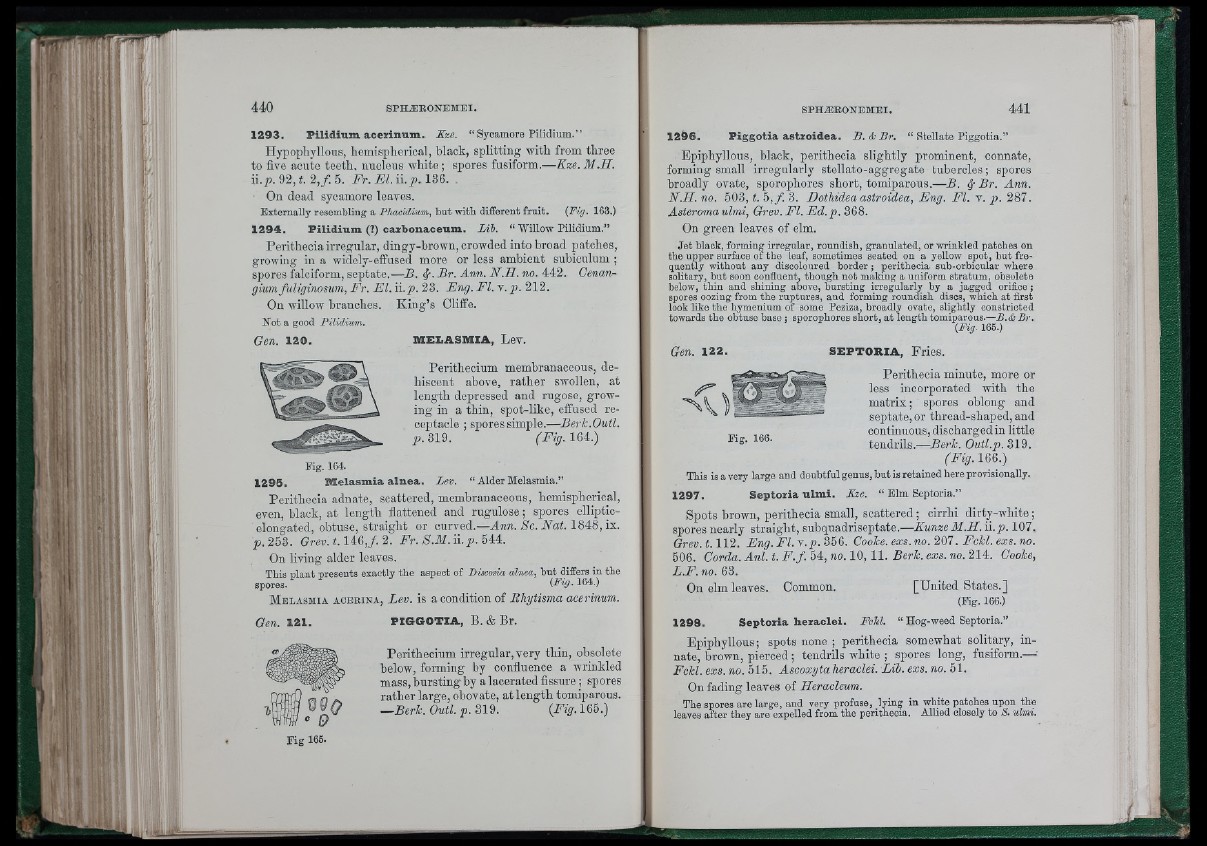
1 2 9 3 . P ilid ium a c e r in um . Kze. “ Sycamore PUidium.”
Hypopbyllous, bemispberical, black, splitting witb from tbree
to five acute teetb, nucleus wbite ; spores fusiform.— Kze. M.H.
ii.)». 92, t. 2 ,/. 5. Fr. E l. ii.)». 136. .
On dead sycamore leaves.
Externally resembling a Phacidium, but with different fruit. (Fig. 163.)
1 2 9 4 . P ilid ium (?) c a rb on a c eum . JUb. “ Willow Pilidium.”
Peritbeoia irregular, dingy-brown, crowded into broad patches,
growing in a widely-effused more or less ambient subiculum ;
spores falciform, septate.—B . / . Br. Ann. N .H . no. 442. Genan-
gium faliginosum, Fr. E l. ii.p. 23. Eng. F l. v. p. 212.
On willow brancbes. King’s Cliffe.
Not a good Pilidium.
Gen. 120. MELASniIA, Lev.
Perithecium membranaceous, dehiscent
above, rather swollen, at
length depressed and rugose, growing
in a tbin, spot-like, effused receptacle
; spores simple.-—Berh.Outl.
p . 319. (Fig. 164.)
Eig. 164.
1 2 9 5 . M e la sm ia a ln e a . Lev. “ Alder Melasmia.”
Perithecia adnate, scattered, membranaceous, hemispberical,
even, black, at length flattened and rugulose; spores elliptic-
elongated, obtuse, straight or curved.—Ann. Sc. N at. 1848, W
p . 253. G r e v .t.l4 6 ,f.2 . Fr. S .M .\\. p . 544.
On living alder leaves.
This plant presents exactly the aspect of Discosia alnea, bnt differs in the
spores. (Fig. 164.)
M elasmia aoeeina. Lev. is a co n dition o f Rhytisma acerinum.
Gen. 121. P IG G O T IA , B. &Br.
Perithecium irregular, very thin, obsolete
below, forming by confluence a wrinkled
mass, bursting by a lacerated fissure ; spores
ratber large, obovate, at length tomiparous.
—Berh. Outl. p. 319. (Fig.165.)
1 2 9 6 . P ig g o tia a str o id e a . B .A B r . “ Stellate Piggotia.”
Epipbyllous, black, perithecia sligbtly prominent, connate,
forming small irregularly stellato-aggregate tubercles ; spores
broadly ovate, sporophores sbort, tomiparous.—B. / Br. Ann.
N.H. no. 503, t. 5 ,f. 3. Dothidea astroidea, Eng. F l. v. p . 287.
Asteromaulmi, Grev. F l. Ed. p. 368.
On green leaves of elm.
Jet black, forming irregular, roundish, granulated, or wrinkled patches on
the upper surface of the leaf, sometimes seated on a yellow spot, but frequently
without any discoloured border ; perithecia suh-orbicular where
solitary, but soon confluent, though not making a uniform stratum, obsolete
below, thin and shining above, bursting irregularly by a jagged orifice ;
spores oozing from the ruptures, and forming roundish discs, which at first
look like the hymenium of some Peziza, broadly ovate, slightly constricted
towards the obtuse base : sporophores short, at length tomiparous.—B .A Br.
(Fig. 165.)
Gen. 12 2 . SE P TO R IA , Pries.
Eig. 166.
Perithecia minute, more or
less incorporated with the
m a trix ; spores oblong and
septate, or thread-shaped, and
continuous, discharged in little
tendrils.—Berk. Outl.p. 319.
(Fig. 166.)
This is a very large and doubtful genus, but is retained here provisionally.
1 2 9 7 . S e p to iia u lm i. Kze. ” Elm Septoria.”
Spots brown, perithecia small, scattered; cirrbi dirty-white;
spores nearly straight, subquadriseptate.— Kunze M .H. ii.)». 107.
Grev. 1.112. Eng. F l. r .p . 356. Cooke, exs. no. 207. Fckl. exs. no.
506. Gorda. A nl. t. E .f . 54, no. 10, 11. Berk. exs. no. 214. Cooke,
L.F . no. 63.
On elm leaves. Common. [United States.]
(Eig. 166.)
1 2 9 8 . S ep to r ia h e r a c le i. FoU. “ Hog-weed Septoria.”
Epipbyllous; spots none ; perithecia somewhat solitary, innate,
brown, pierced; tendrils wbite ; spores long, fusiform.—
Fckl. exs. no. 515. Ascoxyta heraclei. Lib. exs. no. 51.
On fading leaves of Heracleum.
The spores are large, and very profuse, lying in white patches upon the
! after they are expelled from the peritheoia. Allied closely to S. ulmi.